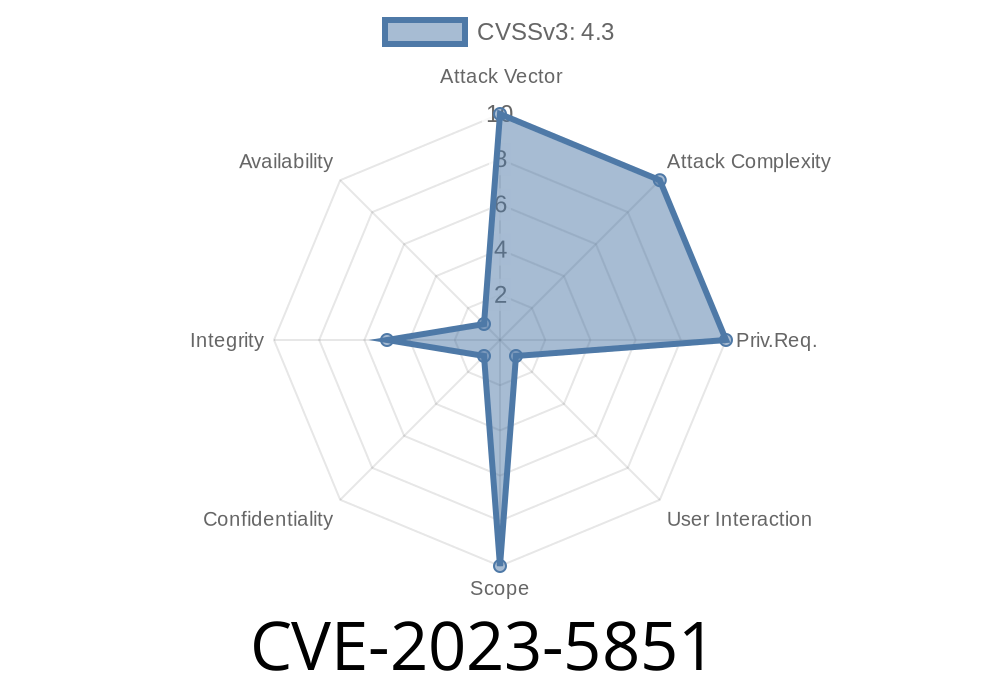In this post, we will discuss a vulnerability labeled as CVE-2023-5851 that was identified in Google Chrome web browser prior to version 119..6045.105. This particular issue stems from an inappropriate implementation in the Downloads feature of Google Chrome, which allows a remote attacker to obfuscate security UI using a crafted HTML page. The Chromium project has assigned a medium severity rating to this vulnerability. Before we dive into the details, let's define a few key terms.
- CVE: Common Vulnerabilities and Exposures (CVE) is a list of publicly disclosed computer security flaws. Each flaw is assigned a unique CVE Identifier (CVE-ID).
- Remote attacker: An individual or group attempting to exploit a vulnerability from a different location than the targeted system.
Security UI: User Interface components related to the security of an application.
Now that we have defined the essential terminologies, let's explore the vulnerability in more detail.
Vulnerability Details
The inappropriate implementation in Google Chrome's Downloads can be exploited by a remote attacker who creates a crafted HTML page. When a user visits this page, the attacker can then obfuscate the security UI of Google Chrome, potentially misleading the user or bypassing security protections.
To better understand the significance and impact of this vulnerability, we need to look at the code snippet that exhibits the issue.
Imagine a malicious HTML page that includes the following code
<!DOCTYPE html>
<html>
<head>
<title>CVE-2023-5851 Example</title>
<style>
/* Obfuscate the download link */
a[download]::before {
content: "Super Safe Download: ";
}
</style>
</head>
<body>
<a href="not_suspicious_file.exe" download="Totally Legit PDF.pdf">Download</a>
</body>
</html>
In this example, we are using the CSS ::before pseudo-element to add content ("Super Safe Download: ") before the actual download link, effectively obfuscating it from the user. The user may be misled into downloading the malicious file, believing it to be a legitimate and safe download.
Original References
You can find the official advisory, including the description, affected products, and fix implementation details here:
- Chromium Security Advisory
- CVE-2023-5851 Record
Exploit Details
Currently, there are no known publicly accessible exploits specifically targeting CVE-2023-5851. However, an attacker familiar with web programming could create a malicious HTML page, as demonstrated in the code snippet above, to take advantage of this vulnerability.
To protect yourself from this vulnerability, you should ensure that your Google Chrome browser is up to date with the latest security patches. To check for updates, go to "Settings" > "About Chrome" and follow any prompts to update your browser.
Conclusion
The inappropriate implementation in downloads in Google Chrome before version 119..6045.105 (CVE-2023-5851) can have serious consequences for users who are unaware of its existence. By obfuscating the security UI using a crafted HTML page, remote attackers can mislead users and potentially compromise their systems. Regularly updating your Google Chrome browser is the best practice to mitigate such vulnerabilities; always make sure you are running an updated version. If you found this post helpful, please consider sharing it with your peers, so they too can better understand this issue and protect themselves.
Timeline
Published on: 11/01/2023 18:15:10 UTC
Last modified on: 11/14/2023 03:15:11 UTC
